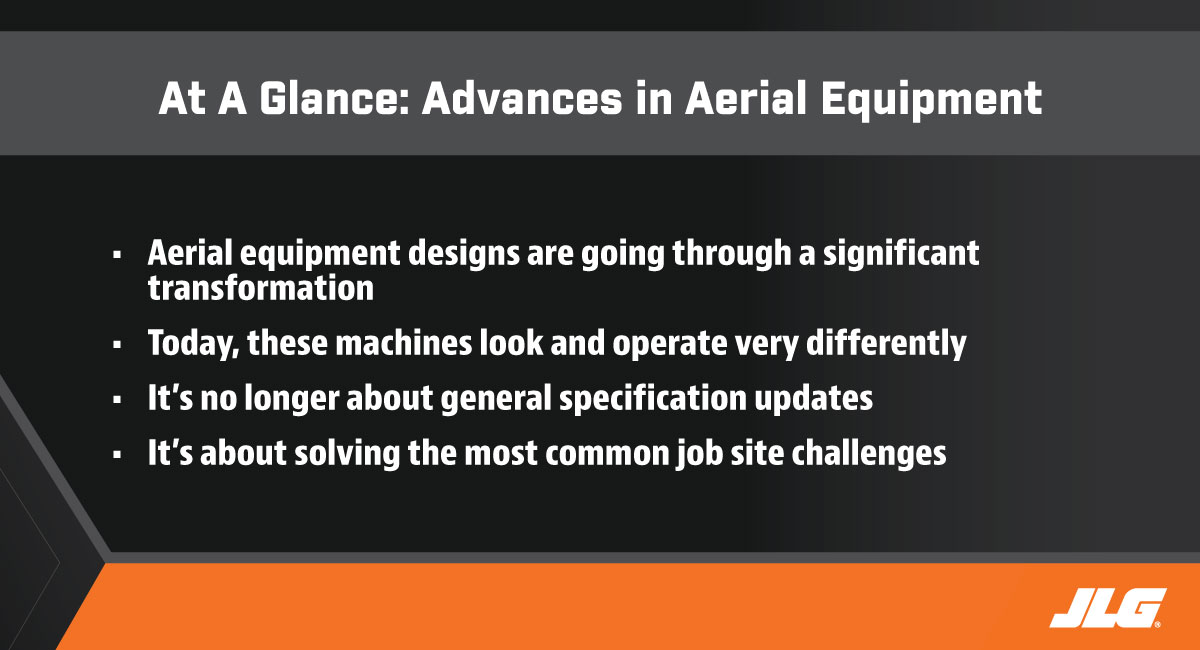Aerial equipment designs are going through a significant transformation. This new generation of machines looks and operates very differently. It’s no longer about general specification updates. It’s about combining innovation with technology to solve the most common job site challenges, like working on uneven or inclined terrain.
Below are excerpts from a recent interview with Ignacy Puszkiewicz, JLG’s Senior Director of Future Technology and Industrial Design, on the latest advances in aerial equipment.

What advances are being incorporated into MEWPs and how are those advances answering customers’ needs?
Some OEMs have focused on developing products that reach further and higher, while others have advanced the machine’s control system technology to enable the equipment to work on steeper slopes.
While these advancements are good and have a place in the market, at JLG, we believe that the access industry's future will be for OEMs to develop practical technology solutions that are nearer to ground level.
Ground-level technology could also save a significant amount of time and money because it would eliminate the need for excessive, costly job site preparation, such as grading work to level surfaces. And, it would eliminate the need for cribbing so these machines could be used on more types of job sites. In turn, the technology allows machines to work closer to buildings with less positioning while providing operators with a more comfortable, stable feeling when operating in rugged conditions.
Several recent developments in machine chassis technology have been developed that now offer operators new ways to be productive when working on uneven terrain. For instance, variable-tilt and self-leveling technologies from JLG are designed to adjust a machine’s capability under certain conditions to the ground or surface being worked on.
Variable-tilt technology, currently available on JLG® scissor lifts, is focused on modifying the machine’s lift height, or work envelope, based on the tilt of the chassis.
Self-leveling technology, soon available on JLG boom lifts, is designed to adjust the lift’s chassis to the ground conditions (rather than adjust the machine’s capability to ground conditions).
What are some of the upsides and downsides/caveats that rental centers need to consider when contemplating on bringing new aerial lifts into their rental fleets?
As the adoption of new technologies that improve operations' efficiency and safety continues to gain momentum in the access industry, OEMs must also make sure that these machines adhere to the current industry standards. In North America, that means that access equipment must comply with the updated ANSI A92 (United States) and CSA B354 (Canada) standards, which went into effect on June 1, 2020.
The Machine Design sections in the ANSI and CSA standards — ANSI A92.20 & CSA B354.6, respectively — specifically addresses the design, calculations, safety requirements and testing methods of MEWPs, which significantly influence how new technology is incorporated into these machines. For example, these machines are now required to have load sensing capabilities, which actively monitor load, sound an alarm and interrupt normal operations if overloaded. And, they must also have a tilt sensor system that will alarm, as well as disable boom and drive functions, if the incline surpasses the slope limit.
Compliance is critical for everyone in the industry because adhering to these standards reduces safety hazards and prevents lost time. But, changes like load sensing and tilt sensing will require operators to do more advanced planning of work at height to make sure that it’s possible to complete with compliant equipment.
With traditional equipment, this means that operators will need to carefully consider the application when choosing a MEWP for the job, but with machines that have advanced ground-level technology, operators will be more easily able to complete the work without extra pre-planning.
These are step changes for the industry — technologies that will truly transform how people work at height by increasing productivity and enhancing safety best practices. As technology evolves, the idea is that these innovations will not only change how the industry works today, but that these advancements will be the way forward too.
To learn more about the latest news on JLG equipment, services, solutions and technologies, click here.
Want to stay up to date with industry news and trends similar to this? Make sure you subscribe below to receive monthly updates from Direct Access with newly posted content so you never miss important information.